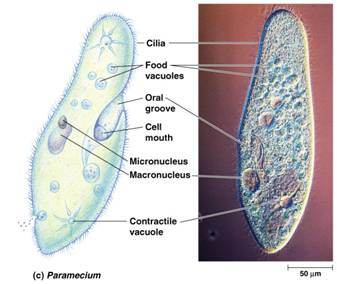A paramecium is a singled celled living organism that belongs to the kingdom Protista. The organisms size is about 0.02 inches in length. They have an oval shape and are rounded on the front and tapered at the end. The organism has a pellicle which gives shape to the organism and allows for small body changes which is an important thing in as far as the movement of the organism is concerned. The pellicle is covered by cilia which are smaller locomotory structures. An oral groove is located near the front end and is usually used in feeding and in excretion. The contractile vacuole also found on the outer of the paramecium aid in locomotion. Enclosed within the cell are other structures including trychocysts, cytoplasm, gullet, macronucleus, food vacuole and micronucleus (Foissner 364).

The pellicle has a protective function just like the skin will protect large organisms. The cilia apart from helping in locomotion, they also assist the organism in bringing food to the oral groove. The oral groove collects food from the surrounding and directs it into the interior of the cell. The cell mouth is what acts as the opening to the digestive system. The anal pore functions in dispelling waste materials from the cell. Extra water from the cell is dispelled from the cell through the contractile vacuole. Contractile vacuole is fitted with radiating canals that act as paths to and from the vacuole. Cytoplasm contains other vital cell components including the nucleus. The trichocysts are more important in defense of the paramecium. There is also a food vacuole which acts as a food store forms from the gullet. The large nucleus called macronucleus is important in performing cell functions while the smaller nucleus (micronucleus) is important during cell division (Foissner 364).
Complete taxonomy
- Super kingdom……………Eukaryote
- Kingdom……………………Animalia (Protista/Protozoa)
- Phylum……………………..Ciliophora
- Class…………………………Ciliatea
- Subclass………………………Rhabdophorina
- Order…………………………..Hymenostomatida
- Suborder………………………Peniculina
- Family………………………….Parameciidae
- Genus………………………….Paramecium
- Species……………………Aurelia
Paramecium Aurelia has been described as a complex species consisting of 15 entities. Despite the fact that this group of free living ciliates show a lot of morphological similarities, the 15 groups or species show distinct variations in terms of their genetic composition. It has also been shown that each of these different species is composed of two kinds of mating members (Beale 17). The mating types are designated as even represented as (E) or odd represented as (O). These mating types are what represent intraspecific reproduction among members of each species through conjugation. Interspecific reproduction has been shown not to occur and this has been proved by placing clones of different species together and later observing that no conjugation occurs. Also, it is worth noting that conjugation does not occur between the same mating types. Members of mating type E cannot conjugate and the same case applies to member of mating type O (Aufderheide 135). However it has reportedly been said that weak cross-reactions may occur between different mating types from different species but the conjugated cells usually die after sometime or if the cells survive, their F1 generation cells show sterility. This phenomenon has been reported among member species of Paramecium tetraurelia and Paramecium octaurelia and also between Paramecium primaurelia and Paramecium pentaurelia (Haggard 153).
Recent studies concerning molecular phylogeny and speciation in species complex of Paramecium aurelia has in a greater extent supported phylogenetic relationships among those species that have been described to have diverged in recent times. Experiments that have been conducted to study the reliability and existence of such phylogenetic relationships has shown that there exists a tendency of members or recently diverged species to cross-react and actually produce viable cell at the end of the conjugation process (Sonneborn 156). This has been proven in members of P. primaurelia and P. pentaurelia. These studies have shown that during the conjugation process, there is close pairing of gene genealogies in all aspects. It is therefore important here to consider the effect of divergence and the phylogenetic impact it has on species (Sonneborn 156).
My choice of this organism is rather personal because am interested in microbiology and am actually focusing on becoming a specialist in this field. Paramecium is a very dynamic genus consisting of free living species. Most importantly, despite the fact that many micro-organism are associated with diseases, most of the paramecium species have not been associated with any. As a matter of fact, many of these species have been of significant importance by the fact that they feed on bacteria and other protists and considering that some most bacteria are associated with human and animal disease (Coleman 23).
The economic importances to humans that can be attached to paramecium are incredible. Some paramecium has been associated with degrading of pollutants in water and therefore helping in the creation of a healthier environment. Also their feeding on some pathogenic microorganism helps to reduce these disease-causing microbes from the environment and therefore saving on the resources that could have been used in the treatment of these diseases. These importances led me to choosing paramecium as my organism of choice.
Works Cited
Aufderheide K, J. Daggett PM, Nerad TA. Paramecium sonneborni N-Sp, a new member of the Paramecium aurelia species-complex. J Protozool. 30 (1983):128–131.
Beale G, Preer J, R. Paramecium: Genetics and Epigenetics. Boca Raton (FL): CRC, 2008. Press.
Coleman A, W. Paramecium aurelia revisited. J Eukaryot Microbiol. 52 (2005):68–77.
Foissner W. Protist diversity: estimates of the near imponderable. Protist. 150 (1999):363–368
Haggard B, W. Interspecies crosses in Paramecium Aurelia (syngen 4 by syngen 8). J Protozool. 21 (1974):152–159.
Sonneborn T, M. The Paramecium-aurelia complex of 14 sibling species. Trans Am Microsc Soc. 94 (1975):155–178.